Running Rituals
The alarm goes off, but we have already been awakened by someone on the street buzzing our door to come up for the encierro. Our balcony overlooks Calle Estafeta, where we can see the bulls on the street below as they run by, so we extend invitations to various friends (and occasional strangers) to come up to watch the ritual running of the bulls. Our instructions are precise: come at the last possible moment, minutes before 7:00 when the street is blocked off for cleaning before the run begins at 8:00. The drop key, permanently tied to a long white string, is lowered through the stairwell to allow our guests to pass the locked door at the bottom of the five flights of stairs to our apartment. We usher them out to our balcony so they can watch the street as it’s prepared for the run, and we go back to bed. That extra twenty minutes of sleep can mean everything.
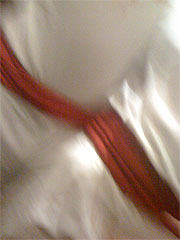
But before 8:00, we, too, must be up, dressed and ready to run. Not with the bulls, but between our living room, where we can see the bull-run on the television, and the balcony, where we charge out as the bulls turn the corner to run up our street. Their broad brown backs rush forward, the bells on the steers that accompany them make the soundtrack to their morning run. On a good day, the bulls are still packed together with the steers as they run toward the corrida, and a few skilled (or lucky) runners sprint ahead of them, just off to the side of their horns.
After the instant replay of the encierro and ensuing TV commentary, we rush our guests out the door and head to the Bar Txoko where many of the runners we know go to swap stories and drink ritual morning drink: Kaiku y Cognac, a sweet vanilla milk mixed with a double-shot of cognac. It so happens that the street cleaners choose that moment to clean the very patch of the Plaza de Castillo where we stand, so we are forever maneuvering our conversations around to accommodate the sweepers and hose-masters who are kindly cleaning up after the previous night’s party, only part of the party that goes on for nine days. These guys are the true heroes of the fiesta, constantly cleaning the streets of the gray goop that is a mixture of beer and wine and urine and puke that accumulates during the week.
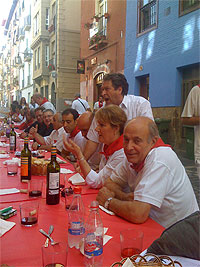
A quick drive-by to greet the brothers Carmelo and Fermín at the newsstand where we buy a paper with the photographs of the previous day’s bullrun and bullfight, and then on to our breakfast club, a long table set up in the street where friends meet to eat greasy eggs or pochas or bull stew. Such nourishment can be acquired anywhere, but we always take it here to be in the company of a few very distinctive jota singers who serenade us with traditional Navarran ballads with poignant lyrics (like wishing to be an ivy vine in order to crawl up to your window just to watch you sleep).
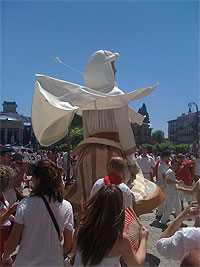
The midday rituals have some variation, but might include a long meander through the city streets in search of the Gigantes, a troupe of eight giant figures that represent the kings and queens of the different continents of the world. This year I saw them no less than a half-dozen times, their towering figures turning side-to-side in an enchanting dance in step to the music of the high pitched txistulari pipers. The Gigantes are at least three times the size of the men who carry and spin them for hours every morning; occasionally you see the figures stop and appear to stand still in the street as the men slip out from under the robes and duck into a nearby bar for a rest and a drink. In the meantime, parents carry their toddlers up close to examine the clumps of pacifiers that dangle from the wrists of the giants. 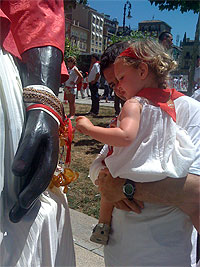 When Pamplonese children are ready to stop using their binkies, they give them up to the Gigantes. This is a ritual I find priceless; I can imagine the conversations between the child and parents as the fiesta approaches, the building up to the ceremonial hand-off of the prized pacifier, tying it to the enormous hand of their chosen Gigante. I had a fine childhood, but if I could do it over, I’d do it in Pamplona.
When Pamplonese children are ready to stop using their binkies, they give them up to the Gigantes. This is a ritual I find priceless; I can imagine the conversations between the child and parents as the fiesta approaches, the building up to the ceremonial hand-off of the prized pacifier, tying it to the enormous hand of their chosen Gigante. I had a fine childhood, but if I could do it over, I’d do it in Pamplona.
This is the moment that seems to have become a ritual for me, when I wonder why Short-pants and Buddy-roo and De-facto are not there with me, swallowed by the sea of white and red and music and magic. I have kept the fiesta San Fermín as my annual escape, but each year I wonder, how can I not share this with them? For how long should it remain my getaway with my girlfriends and my “Pamplona friends?”
The fiesta is embedded with rituals, those offered up by the proud Basque culture, the noble Taurino traditions, not to mention those that my friends and I have invented for ourselves in the years we’ve been attending. Like our Hemingwayesque ritual of taking two days in the green Navarran 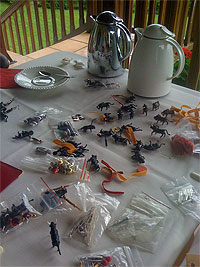 countryside just prior to the start of the fiesta, when my girlfriends and I stay at our favorite B&B. Here we slide into the Basque culture, nibbling our favorite asparagus and drinking homemade Patxaran. We retire early and sleep in, padding the sleep bank before the fiesta quickly depletes it. In the morning, we take over a table to create masterpieces of jewelry we bead together with small plastic bulls that have been borrowed from Tequila bottles from a Mexican Kmart. Our own spontaneous designs that every year we make, wear and give away: the running of the bull-earrings.
countryside just prior to the start of the fiesta, when my girlfriends and I stay at our favorite B&B. Here we slide into the Basque culture, nibbling our favorite asparagus and drinking homemade Patxaran. We retire early and sleep in, padding the sleep bank before the fiesta quickly depletes it. In the morning, we take over a table to create masterpieces of jewelry we bead together with small plastic bulls that have been borrowed from Tequila bottles from a Mexican Kmart. Our own spontaneous designs that every year we make, wear and give away: the running of the bull-earrings.
Each day in Pamplona, a brief afternoon nap rejuvenates us to make the run for sandwiches and cookies (and a chilled bottle of Rosado) to carry into the corrida for the post third bull snack. The bullfight itself is a remarkable ritual, a 3-act drama of skill, bravery and intimacy. Though I am far from an aficionada, there was one moment this year that moved me to tears: the matador raised his hand to stop his cuadrilla as they came to his aide. He knew he had done his work well, the bull was ready to die, and so he stood back with his hand raised, and waited for the bull to fall. It happened swiftly; a good death, with grace and honor, the kind we all hope for. It made me think of my mother, of course, how nobly she fought during the last year of her life, and the dignity of how she finally let go.
Each year I painfully extract myself from my friends and the festivities and leave to be with Short-pants to celebrate her birthday, which falls the day before the end of the fiesta. I could have gotten a pass this year, I suppose, having done my duty with the big party last month, except that I want to be with her on her birthday. As hard as it is to leave the fiesta early, the return is always a relief. This year was no exception: I was as glad as ever to see De-facto and the girls waiting for me at the train station, waving wildly when they spotted me.
“I missed you so much,” cried Short-pants, throwing her long arms around me. “Where did you get those white shoes?” said Buddy-roo, who notices everything, especially if it has to do with new items of clothing or jewelry.
Over the last few days, the final post-fiesta rituals have been enacted without fail: the detoxification, the redepositing of sleep in the bank; the gradual removal of those haggard circles under my eyes; the return to an exercise regime to address the abnormal number of carbohydrates consumed at the fiesta; the washing of the whites, which requires the special formula of 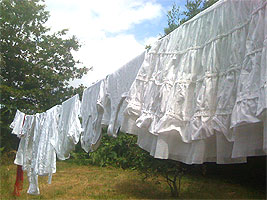 bleach and Coca-Cola (this tip given to us by a Spanish grandmother we met in the supermarket) to get that gray goop off the bottom of all my white jeans; the telling of stories (only mildly toned down) and the fierce expression of gratitude toward De-facto, who always lets me run just as far as I need.
bleach and Coca-Cola (this tip given to us by a Spanish grandmother we met in the supermarket) to get that gray goop off the bottom of all my white jeans; the telling of stories (only mildly toned down) and the fierce expression of gratitude toward De-facto, who always lets me run just as far as I need.
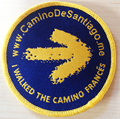
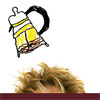
July 19th, 2010 at 6:39 pm
Wonderful. And that last part of that last long line took my breath away, and brought a little tear to my eye. You’ve got it, that extraordinary life you used to talk about. You never said perfect, just extraordinary.
July 22nd, 2010 at 10:01 am
wow… que espectaculo! nunca entendi demasiado bien el espiritu de la fiesta de San Fermin (I just remember how much one of my acquired mums loved it and sang the songs, she was my cousins grandmother, Elena Montero, a spanish inmigrant in Argentina).
pero gracias a tu post ahora la amo! espero ir algun dia! besos
July 24th, 2010 at 5:02 am
When my daughter is ready to quit her pacifier, I now know how we’ll do it!
September 14th, 2012 at 8:26 pm
Fantaatic reading about our San Fermin festival
Keep up the good work
PamplonaMan